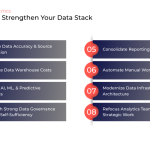
AI is doing for digital marketing what the internet did for communication and commerce. For digital marketers, this represents a shift in how they approach strategy, automation, and customer engagement. Businesses that adopt AI assistants today are building faster workflows, uncovering smarter insights, and forming deeper customer connections.
The Internet Changed the Game for Businesses
When the internet became mainstream, it opened new ways for brands to reach customers, measure impact, and grow revenue. Companies that resisted digital transformation like Blockbuster, Xerox, and even MySpace were left behind.
AI is following a similar path. No longer a futuristic concept, it's becoming embedded in the daily workflows of marketers across industries. Early adopters are seeing the same advantages that came with the internet: accelerated growth, more efficient operations, and more personalized customer experiences.

Three Ways AI Assistants Can Power Modern Marketing
Here's how forward-thinking marketers are already using AI to streamline their work and unlock new opportunities:
Automated Reporting and Analytics
AI can generate campaign summaries in seconds, highlight unexpected trends, and recommend optimizations based on real-time data.
Instead of digging through email attachments or exporting reports from Google Analytics, marketers can ask their assistant for a summary, key takeaways, or next steps. Human judgment still plays a role in reviewing and customizing these recommendations before sharing them with clients or internal teams.
Content Generation and Personalized Messaging
AI can be trained on historical data, brand voice, and marketing materials to write email subject lines, ad copy, and social media posts that stay on-brand. This allows teams to focus more on storytelling, campaign development, and brand strategy.
Competitor Monitoring and Market Research
AI can scan articles, SEO data, paid ads, and social channels to track competitor activity and detect shifts in the market, giving teams early signals about what is changing and where to focus, without manually gathering data.
Evolving the Marketing Role: From Tasks Doer to AI Orchestrator
With AI capabilities available, digital marketers are now the orchestrators of intelligent workflows.
This new role involves:
- Building processes that combine human expertise with AI.
- Using prompt engineering to get better results from AI tools.
- Validating outputs before they are shared with clients or stakeholders (no one's perfect!)
Using AI is about multiplying your impact and delivering more value with less manual effort.
Getting Started with AI in Your Workflow
Here are four steps to begin integrating AI into your marketing operations:
Start Small
Experiment with AI tools that automate reporting, content suggestions, or basic customer segmentation.
Build AI Literacy
Understand what AI can and cannot do. Learn how tools like large language models, natural language processing, and recommendation systems work in a marketing context. The more you understand the capabilities and limitations, the more effectively you can use it.
Integrate Gradually
Add AI to the tools and workflows you already use. Whether it's generating summaries in Slack, tagging content in your CRM, or helping with dashboards, let AI enhance your current workflow.
Learn to Effectively Prompt AI
Prompting is key! Clear instructions, relevant context, and consistent formatting help you get better results. The more you practice and iterate on your prompts, the better you'll become at getting the results you want.
Ready to Bring AI into Your Marketing Stack?
Calibrate Analytics helps digital teams go beyond basic AI use cases by connecting assistants to proprietary business data and enabling real-time responses, making a true impact on the bottom line.
Contact us today if you're ready to bring AI into your organization.





